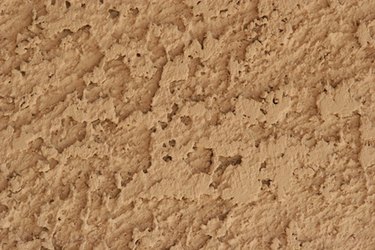
Stucco is a wall-cladding that is commonly found on the outside of homes. Most stucco is light in color; it can become stained, and these stains can be very obvious. Such stains may be caused by dirt, soot, grease, mold, mildew or rust. Most of these exterior stucco stains can be removed with a mild detergent and a pressure washer on a low setting. Other stucco stains, such as mold stains, may have more serious underlying causes and require repair of the exterior stucco.
Dirt or Grease Stains
Video of the Day
Dirt and grease stains are the most common stains found on exterior stucco. The primary cause of these stains is being too close in proximity to other objects, or rain. For example, a driveway may be too close to the stucco, resulting in grease stains from vehicles being transferred to the stucco. In the case of dirt stains, trees, bushes or gardens may be the culprits. This is especially prevalent if a sprinkler is located near the exterior wall, driving dirt and water onto it and causing stains. Dirt and grease can easily be tracked onto stucco if it is close the ground, and rain can cause dirt and grease to splash up onto the exterior surface.
Video of the Day
Rust Stains
Rust stains are also common on exterior stucco. They may be caused by rust emanating from nearby metal objects, such as vent covers or grates. If the exterior stucco is synthetic and composed of layers of foam board with a stucco coating, the studs used to secure the boards may be rusting underneath, leading to rust stains on the surface of the wall. If the stucco is not synthetic, underlying wires may still be rusting and causing surface stains.
Mold or Mildew Stains
Mold or mildew stains may appear on the stucco if it gets wet and can't dry properly because of an object too close to or around it. In the worst-case scenario, synthetic exterior stucco becomes mildewed as the result of an internal leak, causing serious mold issues that can affect the structural integrity of the home.
Soot Stains
Chimneys made of stucco often develop soot stains. These stains will look black and greasy, and can be difficult to remove, requiring specialized cleansers. Grills can also cause soot stains on stucco if they are in close proximity to the wall.